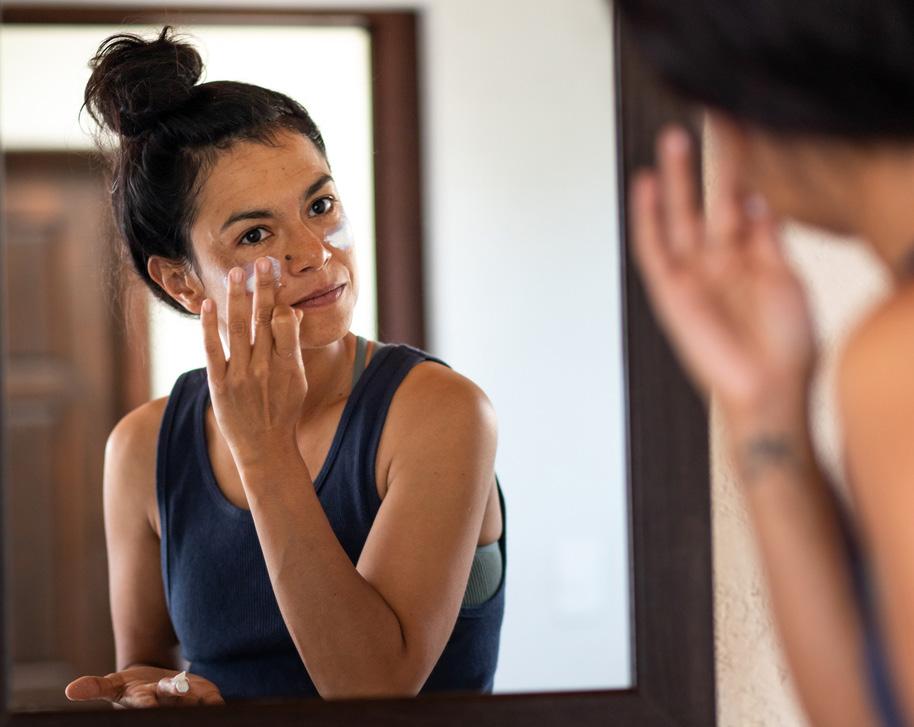
9 minute read
Avoid Getting Burned: A Look into Deadly Skin Cancer
Skin cancer is one of the most common cancers diagnosed in the United States, with more than 1 million Americans living with melanoma, the most dangerous type of skin cancer, according to the American Academy of Dermatology (AAD). Additionally, it is estimated that one in five Americans will develop skin cancer in their lifetime. While this may or may not be a startling statistic, it illustrates the importance of preventive care and early detection.
Regularly examining your skin for any changes can help identify potential cancer and lead you to a dermatologist for analysis and then an oncologist for high-risk and advanced cases. The Centers for Disease Control and Prevention recommends following the A-B-C-D-Es of skin cancer.
A - Asymmetrical. Is the mole or spot that you’ve identified an irregular shape that looks different?
B - Border. Is the border around the mole or spot irregular or jagged?
C - Color. Is the color of the mole or spot uneven?
D - Diameter. Is the mole or spot larger than the size of a pea?
E - Evolving. Has the mole or spot changed during the past few weeks or months?
It is important to be familiar with your skin, so you can notice when changes occur,” explained Dr. Trevor Austin, Board-certified medical oncologist and hematologist at Messino Cancer Centers. “Self-skin examinations and routine screening with your physician are the key to early diagnosis. The earlier melanoma is diagnosed the more likely it is to be cured.
The Sun’s Two-Faced Rays: UVA and UVB Explained
Both types of ultraviolet (UV) rays are emitted from the sun. The Skin Cancer Foundation explains that UVA rays have longer wavelengths and are associated with skin aging, and UVB rays have shorter wavelengths and are associated with skin burning. Despite the different wavelengths, both can contribute to skin cancer.
Here are 11 quick facts about these harmful rays:
UVA rays correlate to the “broad-spectrum protection” that is displayed on sunscreen product labels.
UVA rays penetrate your skin deeper than UVB rays; however, UVA rays are slightly less intense than their counterparts.
UVA radiation is mainly used in tanning beds, which is unsafe.
UVA rays can be harmful even if you are inside, as they can penetrate windows and clouds.
UVB rays damage the outer layer of skin, cause suntans, sunburns and even blistering.
UVB rays are associated with the “SPF or Sun Protection Factor” that is displayed on sunscreen product labels.
While UVA rays remain constant, UVB rays fluctuate, meaning they can be more intense in the late morning and mid-afternoon between the spring and fall seasons.
UVB rays can be filtered but are unable to penetrate windows.
Most non-melanoma skin cancers and a large segment of melanoma diagnoses are from UV radiation exposure from the sun.
Damage from UV radiation is cumulative, increasing the risk of skin cancer with each new exposure.
Your body cannot heal some of the DNA damage in the skin cells caused by exposure to UV radiation, which can lead to malignant tumors.

Separating Fact from Fiction: Common Myths About Skin Cancer
There are several myths and misconceptions about skin cancer that can lead to delayed diagnoses and unnecessary anxiety. Here are some of the more prevalent skin cancer myths from the American Cancer Society (ACS) and the AAD so that you can take better care of your skin.
Myth: Skin cancer is rare, and not many people are diagnosed with it.
Fact: As mentioned, skin cancer is one of the most common cancers diagnosed. The AAD has reported that about 9,500 people in the United States receive a skin cancer diagnosis every day.
Myth: Skin cancer can only be caused by sun exposure.
Fact: While this is a common cause of skin cancer, other factors can lead to this diagnosis. For example, UV exposure from not only the sun but tanning beds and sun lamps are risky. Tanning beds can lead to skin cancer, wrinkles, sunspots, freckles and loss of skin firmness. For this reason, sunless tanning is recommended for those who’d like some color on their skin. The safe thing to remember is that there are no safe UV rays.
Myth: Skin cancer only occurs in populations with lighter skin tones.
Fact: Those with lighter skin tones are at higher risk of developing skin cancer, but this does not mean that those who have darker skin complexions do not get diagnosed. Furthermore, it has been found that skin cancer is often discovered at later stages in individuals with darker skin tones because it is not always easily visible.
Myth: Skin cancer does not occur for individuals who tan easily.
Fact: This is a popular belief among the larger population. In fact, a tan is a sign of skin damage, and having a tan does not protect your skin from skin cancer or from getting a sunburn, according to the U.S. Food & Drug Administration (FDA). Tanning is the body’s reaction to UVA rays that penetrate the outermost layer of the skin and as a result, darken the skin to prevent further damage.
Myth: Skin cancer only occurs in individuals whose routine involves the outdoors.
Fact: Simple, daily activities that expose your skin to the sun can increase your risk of developing skin cancer. Activities such as driving with the sunroof open and walking around outside in the sun, for example, can damage your skin and lead to cancer.
Myth: Sunscreen is not needed on a cloudy day.
Fact: Even on gloomy days when the sun is not fully out, its harmful rays pierce through the clouds and can reach your skin. Wearing sunscreen, even on cloudy days, should be a priority to be fully protected.
Myth: By wearing sunscreen, you can stay in the sun as long as you want.
Fact: No sunscreen completely shields your skin from the sun, and you should avoid being outside during peak hours when the sun is strongest — between 10:00 a.m. and 4:00 p.m.
What About the Lesser-Known Culprits: Other Skin Cancer Causes
Sun exposure is widely recognized as the primary culprit behind skin cancer. However, the development is not always solely attributed to spending time in the sun. Here are several lesser-known causes of skin cancer, exploring factors beyond UV rays that can cause the growth of abnormal cells, as explained by the ACS.
Having a fairer skin tone. This does not mean that those with darker complexions are immune to skin cancer. Lighter-colored skin does not have high levels of melanin, the pigment that develops the skin’s color and provides some protection against the sun.
Growing older. Older people are at higher risk of skin cancer. This may be because of the sun exposure they have experienced throughout their life, which has built upon over time.
Being a certain gender. Men are more likely to be diagnosed with basal and squamous cell cancer than women. Again, this may be attributed to this population getting more sun.
Being exposed to certain harmful chemicals like arsenic. Other chemicals that may increase the risk of skin cancer are coal tar, paraffin and types of petroleum products.
Having been exposed to radiation from previous treatments.
Having previously been diagnosed with skin cancer.
Having a weaker immune system. In this case, the tumor often grows faster and may be more challenging to treat.
Being diagnosed with the HPV (human papillomavirus) infection. Some HPV types that are found in certain areas of the body can be related to squamous cell cancer.
Being a frequent smoker.
Having a family history of melanoma or other skin cancer.

Video: What melanoma cancer is and how it can be prevented
Barriers to Optimal Skin Cancer Care
Self-examinations of your skin and then consulting a healthcare professional about any discovered abnormalities are the keys to early detection and successfully treating skin cancer. However, despite this knowledge, many people forgo the recommended screenings for various reasons. These obstacles range from a lack of education to misconceptions and access:
Being unaware of the importance of skin self-examination and screenings.
Lacking knowledge about skin cancer.
Believing tanning and a darker complexion are not harmful and that fair-skinned people are mainly at risk of skin cancer.
Being fearful of a positive skin cancer diagnosis.
Not having a dermatologist or primary physician who can emphasize the importance of skin cancer screenings.
Experiencing uncertainty or a belief about the high costs of seeing a dermatologist for a skin cancer screening and having follow-ups and treatments.
These barriers can deter many people from frequent self-examinations and skin cancer screenings. Still, it must be taught that early detection is paramount in the overall success of a cancer treatment plan. Fortunately, the expertise of dermatologists and oncologists can greatly improve patients’ chances of a positive outcome.
A Collaborative Approach Between a Dermatologist and Oncologist
Dermatologists typically analyze suspicious lesions and other skin abnormalities and confirm skin cancer diagnoses, often through biopsies. They can frequently treat these cancers on an outpatient basis. However, for advanced, high risk or rare cases, an oncologist becomes involved.
This new team may include a medical oncologist, surgical oncologist and radiation oncologist, along with a pathologist, care coordination nurse and dietitian, dedicated pharmacists and other specialists to provide comprehensive support throughout the cancer care journey.
The Future of Skin Cancer Detection
Clinical oncology advancements and the use of AI-based software and tools that use machine learning are on the horizon within the industry. With the goal of decreasing diagnostic errors and improving the speed-to-treat timeframe, physicians are becoming more comfortable with AI assisting them in disease detection and diagnosis — serving as an additional tool in these critical stages. In skin cancer detection, advancements are just as evident and being pursued further to enhance the patient experience and overall health outcomes.
Understanding the realities of skin cancer and taking advantage of preventive measures like self-examinations and scheduling routine screenings will minimize your risk of skin cancer and help you enjoy a lifetime of healthy skin.








